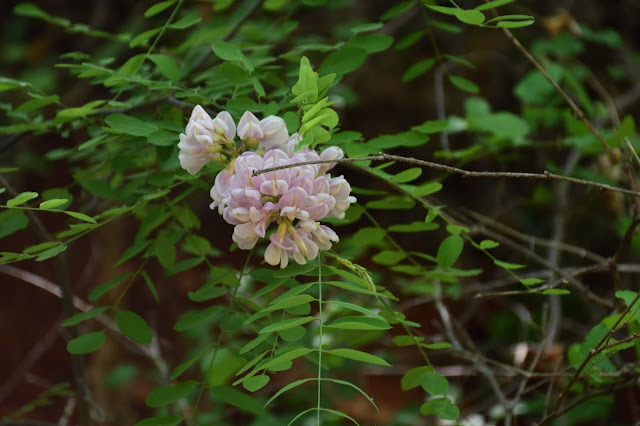On the way back from the Grand Canyon, we stopped in Sedona for lunch and a walk around
Red Rock State Park. Here are some glimpses of the canyon landscape as you drive south into Sedona.
This is one of the more spectacular views from the main street of town itself.
Red Rock State Park is relatively small, but a nice oasis of greenery (something I miss a lot in the desert). It was so nice to walk under sycamores, box elders, and alders, as well as to hear the sound of the creek running through the park.
 |
Sycamores are some of my favorite trees. Given their dependence on water, they aren't as common in Arizona as on the
east coast, but right along riverbeds you sometimes find the Arizona Sycamore, Platanus wrightii. |

 |
| Several trails cross Oak Creek as it passes through the park. |
We saw lots of these whiptails. My best guess on species is that it's a plateau striped whiptail (
Aspidoscelis velox).
The highlight of the day was definitely the family of mule deer that we saw grazing in the woods, especially the adorable young fawn with comically large ears.

We also saw what I think was probably a cardinal--although it was difficult to tell, sitting at the very top of a sycamore--and several beautiful damselflies.
Although far from an all-inclusive survey, here are many of the tree species that we saw as we walked through the park. While I feel pretty confident in the genus-level identification, some of the species are just my best guesses, especially based on known ranges.
Boxelder (Acer negundo), a species of maple with compound leaves that look like a set of three squished and elongated red maple leaves.
Velvet or Arizona Ash (Fraxinus velutina).
Arizona Alder (Alnus oblongifolia).
This oak had holly-like leaves, but the typical oak catkins. I think it is probably a turbinella oak (
Quercus turbinella).
The in-bloom New Mexico locust (
Robinia neomexicana).

Whitethorn acacia (
Vachellia constricta).
Velvet mesquite (
Prosopis velutina).
Arizona cypress (
Cupressus arizonica).
There were also grape vines everywhere, presumably Arizona grape (
Vitis arizonica).
One of my favorite new-to-me species was the surprisingly pretty white horsenettle or silverleaf nightshade (
Solanum elaeagnifolium), which is closely related to tomatoes, potatoes, and eggplant (all genus
Solanum). There were still bright yellow berries on some of the plants.
And here are two final views of Sedona's distinctive red rocks from the parking lot.

























































